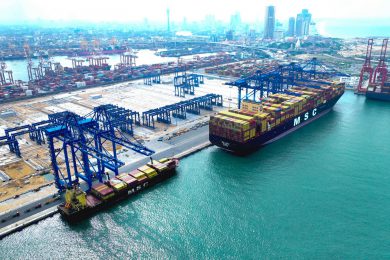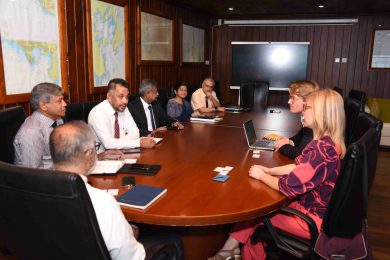“Port of Colombo and other related ports are being developed holistically and simultaneously. SLPA has left no stone unturned since the plans were laid,” Chairman of the Sri Lanka Ports Authority Dr Prasantha Jayamanna (featured image) said in an interview with Rochelle Palipane Gunaratne of The Bridge, a regular publication of the Ceylon Association of Shipping Agents (CASA). “I believe that skeptics were a plenty but we have seen the results as the promises made are gradually coming into fruition on our part,” he observed while elaborating the vitality of collective responsibility of experts in the industry.
Excerpts of the Interview,
Question: Sri Lanka Port Authority always had a vision of making Sri Lanka a maritime hub. What are the initial steps which need to be taken to make this vision a reality?
Answer: A hub is a conglomerate of activities which includes good connectivity for transshipment containers, speedy transitions within the port, efficient service and fewer formalities in the process. The Port of Colombo has been growing at a rate while simultaneously excelling in a number of areas but if we are intent on reaching the goal, we need to increase the capacity. At present, we only do .3% of multi country consolidation (MCC) LCL which is less than 29000 containers, proving the necessity for creating capacity as it is vital for functionality of a hub port. In order to supplement this requirement we are modernizing our existing warehouses which are BQ and CFS, providing civil construction and enhancement and making the logistic sector facilities uplifting and digitally sound. Furthermore, we are on the verge of finalizing the Battenburg Logistics Center and initiating a Request for Proposal (RFP) for the Bloemendhal Logistics Centre as well.
Our immediate concern is to improve the ease of doing business index and to do so, we have engaged in the Port Community System related development with digitization gaining ground in various levels and wherever possible.
The above proves that we are stealthily forging ahead in our quest to achieve maritime hub status in the near future. The establishment of ECT (East Container Terminal) as a semiautomatic terminal will enhance the efficiency spoken of earlier and the CWIT (Colombo West International Terminal) Consortium with its advanced terminal will follow suit. As well, the next phase is gradually being implemented with the establishment of the West Container Terminal two and the North Port development with its ongoing feasibility studies being conducted at present, along with the consultation work. Our immediate concern is to improve the ease of doing business index and to do so, we have engaged in the Port Community System related development with digitization gaining ground in various levels and wherever possible. As of now there is stakeholder involvement taking place and by August 2022, we are expecting the consultants to facilitate the final RFPs which can be released subsequently.
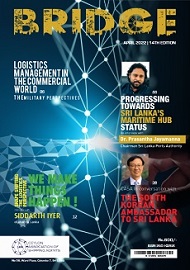
Moreover, the manner we plan to build on this initiative is by inviting private parties also to invest, with SLPA ( Sri Lanka Ports Authority) acting as a stakeholder. The vision is being reached through a step by step process within a stipulated framework. We see the initial infrastructure being laid and we have all the vital components in place to enhance the vision of becoming Asia’s foremost maritime hub.
Q: What are the challenges you face in achieving this vision?
A: Port related matters are frequently protracted as the decision made cannot be implemented immediately. However, there are certain exceptions to the rule, similar to the modernization of the BQ Warehouse which was a rapid fire decision set in motion from the onset as our engineers drew the designs, built the initial platform and validated it. Thereafter, we commenced full scale construction which will be completed within a short time span of merely six months. Yet we encountered a race against time in areas of terminal development and infrastructure replacements. We do not consider bureaucratic red tape as a challenge as the SLPA Act encompasses numerous elements which are extremely comprehensive and power packed. Furthermore, we have a competent workforce comprising of forward thinkers and a professional corporate savvy privately owned terminal force who are part of the broader network which has minimized the challenges we face.
We do not consider bureaucratic red tape as a challenge as the SLPA Act encompasses numerous elements which are extremely comprehensive and power packed.
Q: What are the new investments expected in Port of Colombo?
A: The Shareholder Agreement pertaining to CWIT has already been signed, amounting to 650 million, in addition to the USD 600 million dollar investment pertaining to ECT. Further, the establishing of Batternburg is at an advanced level and we are expecting more investments for Bloemendhal among our real estate investments as we plan to use the real estate owned by SLPA in a financially viable manner. Major shipping lines have also shown an interest to utilize our space to operationalize multi-country consolidation with advance talks taking place at this juncture as the initial validations were satisfactory. Incidentally, JCT (Jaya Container Terminal) investment expansions are in the process of creating three additional berths which are due to be completed soon. The formation of three new berths for the oil/ fuel ships to anchor and pump their fuel averts congestion and delays to a great degree. This will result in the reduction of cost for importing in the oil bunkering business. There is also a plan underway to increase the capacity at JCT by 24000 tons with the implementation of a Private Public Partnership.

Q: Port of Colombo will have to compete with large deep water terminals in the region. What strategies do we have to remain competitive in the region?
A: In any business there are core–competitive advantages. One of our most strategic competitive advantages is the location, yet the improvement in efficiency, ease of doing business and connectivity is pivotal to securing a larger scope of global shipping. I perceive Asia as an engine of growth and there are certain shipments which inevitably cross our shipping route, therefore we should be on par with international requirements and enhance our performance in order to attract the customers while being open to new investments, partnerships and alliances in multi-faceted areas. Even at this stage we are competing with the likes of Malaysia and Singapore and I believe that we should scale up on areas such as efficiency and earning the loyalty of our customers which we tend to lag behind in as it will be an added advantage in attracting more vessels to port.
Q: Being the second largest natural Harbour in the world, the Trincomalee Port is often overlooked. What plans do you have to develop this port?
A: Trinco is in our radar. Apart from minor navigation aids that we have installed, we need a colossal clincher for Trincomalee port. During the last two decades the port was embroiled in regulation related prohibitions with a limited number from the industry zone monopolizing the maritime traffic. This led to Hon. Rohitha Abeygunawardena, former Minister of Ports and Shipping granting access to the business community to invest through the removal of the inhibition clause. The Port will inadvertently get more coverage during the end or beginning of May at the symposium which calls for the Expression of Interest (EoI) to develop Trincomalee port as an Industrial Port. I envision Trinco Port as a break-bulk port, while Colombo can be a more greener, container handling port. Let Trinco be transformed into an iconic, industrially, vibrant port which can utilize all the natural resources and the expanse of lands over there. Since it’s a natural port we need not build breakwaters, instead, we have plans to build a 20m deep terminal. We want the big ships to utilize the facilities with economies of scale for any party involved in expanding industries.
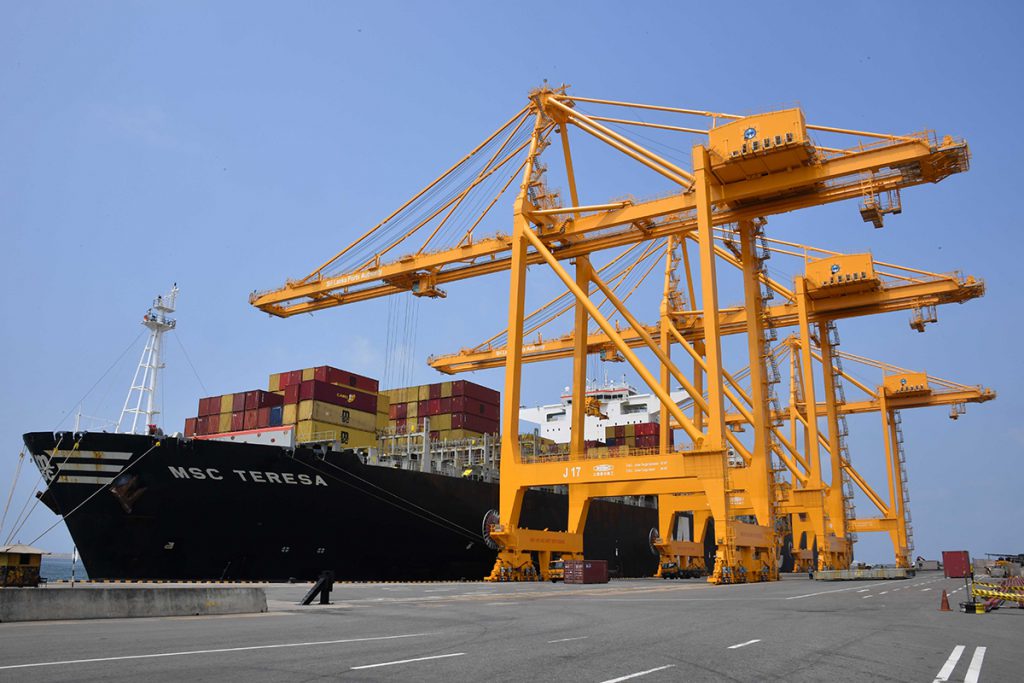
Q: What do you think is the role played by Port of Hambanthota in the journey to become a Maritime Hub?
A: It is indeed an advantage to have international players especially a strong contender like China Merchant Company which has a global presence and experience in the business to operate the Port in Hambanthota but personally, I would have been glad if SLPA was given the management as a SL facility. Nevertheless, Hambanthota and Sri Lanka receives recognition in the global maritime sphere through this intervention as this renowned group utilizes their business savvy, connections and deep pockets to develop these ports. I have always been impressed by the multi-faceted business platform I encounter upon my visits to the HIPG as SLPA is a shareholder. The business approach is versatile and includes roll on/roll off shipping (RORO) which is not handled in Colombo. Surmise it to say, it is beneficial to have partners who are value creators to the country as they will inevitably contribute towards our goal to be a maritime hub by adding the required synergies.
Let Trinco be transformed into an iconic, industrially, vibrant port which can utilize all the natural resources and the expanse of lands over there.
Q: Vessels are becoming larger in size. Therefore investing on deep water terminals is crucial. What progress have we made in operationalizing the East Container Terminal and West Container Terminal?
A: We can confidently proclaim that it’s all on track as work is in progress, while the civil construction is being monitored every three weeks and the equipment has been ordered. We are also enabling the viewing of the construction through a pictorial update which is merely a click away as a sub-heading in the SLPA website, so stay tuned! I twittered an image upon commencement of the dredging which took place on a memorable day – 22/2/22, widely known as ‘Twos-day.’ Coincidentally, it was one the grandest palindromes in the world, thus the day holds a great significance in the local maritime sphere as well.
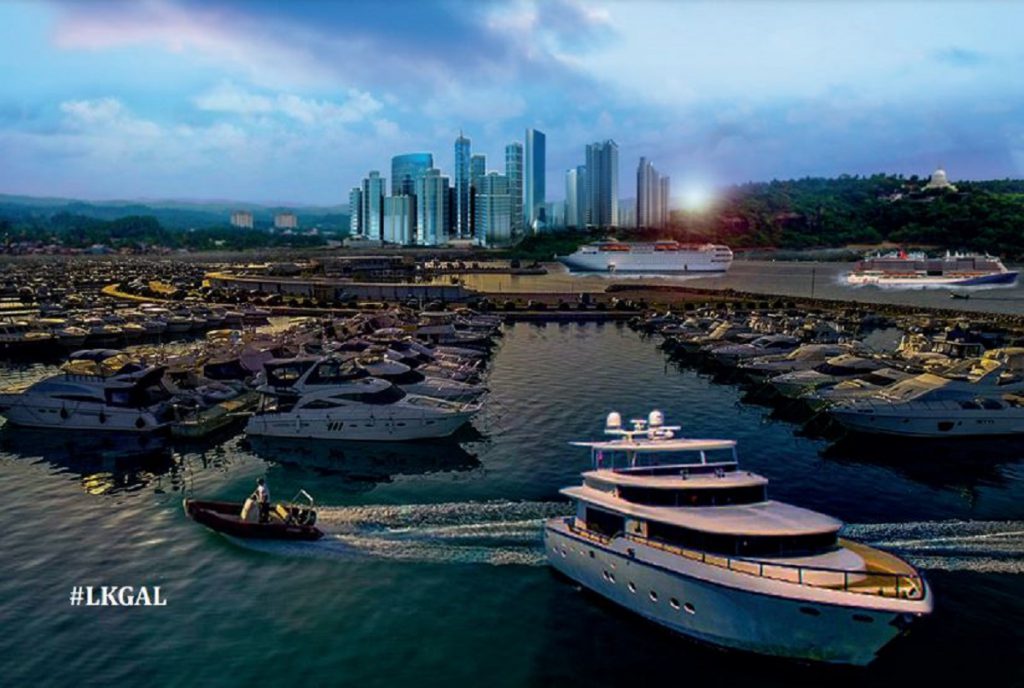
Q: What is the progress made on the marine yacht facility at the Galle Port? Do you see this as an opportunity?
A: On January 26 we held a symposium on the Galle Port and on February 09 an EoI was released calling for investors. Based upon the interest, we will either decide on an individual or a consortium based investment as Galle is a jewel and is the only port that can be developed into a tourist port.
Q: Cruise tourism is a highly potential sector for tourism in Sri Lanka. A fully-fledged passenger terminal is very important to develop this sector. Please brief us on the initiatives taken to develop a fully-fledged passenger terminal.
A: This is the sole reason for developing the Galle Port as a tourist port for cruise ships as it will inevitably enable the development of a passenger terminal at the picturesque location, considered a global heritage site. Yes, as per our blue print we should have one in Colombo but I am focusing on Galle as it’s an authentic tourist destination which can also accommodate larger vessels. Subsequently, we can divert our attention to the development of a passenger terminal in Colombo.
According to the scheduled timelines, there will be a remarkable progress with a futuristic approach towards digital transformation.
Q: How do you see Digitalization affecting shipping and Ports?
A: Are we ready for digitalization? We are already on track with the Port Community System and we have upgraded our Terminal Operation System to N4, without any hiccup, which is the highest level system for planning. During our meeting with the Ceylon Association for Shipping Agents (CASA), they mentioned that except for Port Health office related matters, all other areas are on the path to digitalization of the processes – unlike in the past an email per se would suffice at present. After the completion of BQ Civil Construction the warehouses are to be digitalized with modernization being completed within the next six months, enabling customers to track cargo, further to the incorporation of coding and tracking mechanisms. According to the scheduled timelines there will be a remarkable progress with a futuristic approach towards digital transformation.
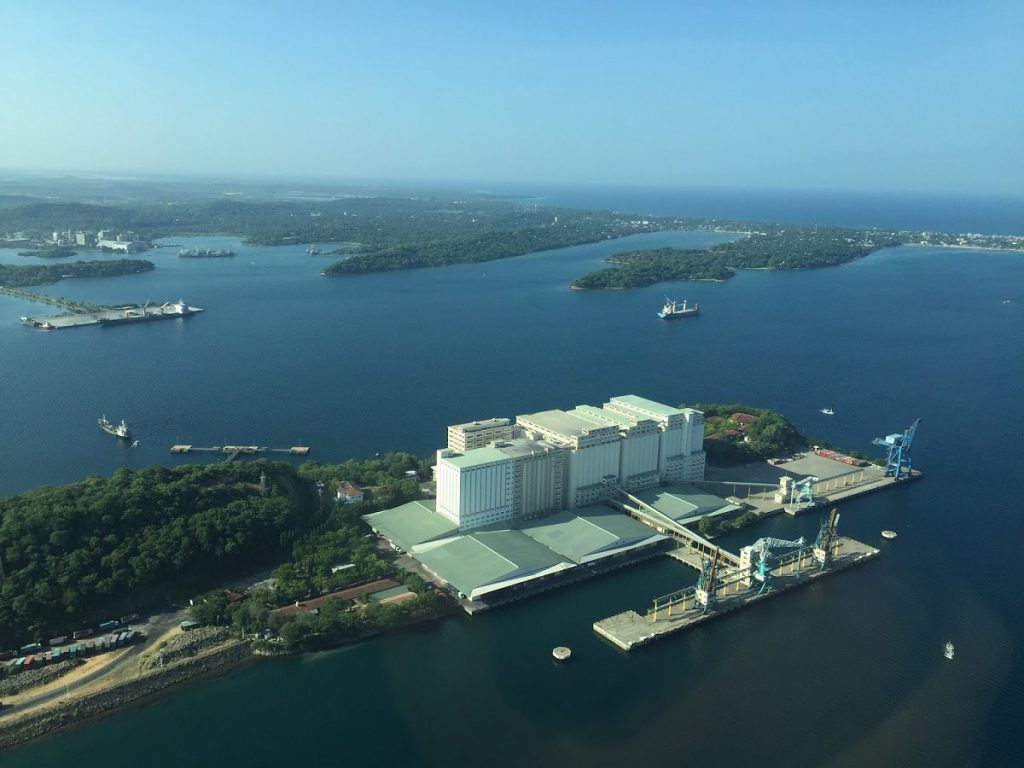
CASA’s involvement is crucial and timely in reinventing our processes in progressing to the next level and it is important to join hands with associations such as this in order to achieve our ultimate goal.
Q: What role do you expect the logistics and shipping industry to play in order to achieve the objective of maritime hub status?
A: We urge the logistics and shipping industry to bring more investments without requesting more rebates. Port of Colombo and other related ports are being developed holistically and simultaneously. SLPA has left no stone unturned since the plans were laid. I believe that skeptics were a plenty but we have seen the results as the promises made are gradually coming into fruition on our part. Therefore we invite you to reinvent your strategies and regulate what we have commenced through an innovative approach to development. It is imperative to invest in the burgeoning demand in front of us as it’s a watershed moment for Sri Lanka maritime. While the veterans in the industry and forefathers were instrumental in building the industry, it is time for the future generation to take the mantle and run the gauntlet with gusto and new vigour – think beyond the proverbial box in moving the industry to greater heights. CASA’s involvement is crucial and timely in reinventing our processes in progressing to the next level and it is important to join hands with associations such as this in order to achieve our ultimate goal.
Q: Has the current Forex crisis led to a backlog in the port, if yes what action is currently being taken on this matter.
A: We have granted a waiver therefore we have no backlog and no major crisis with numbers related to containers as the standard momentum continues without disruptions.
Q: How do you plan on implementing the green port concept at the Port of Colombo?
A: I believe that change should start within us, therefore this initiative will be a pioneer effort – the first ever concept to be manifested in a SL port in which our target is to reduce emissions through a ‘zero emission policy’. Commuters within the port are given bicycles with one hundred bicycles which were donated by Ceylon Association of Shipping Agents (CASA) being launched as an introductory measure towards the maintenance of health and vitality among our staff. Simultaneously, our Directors will be entrusted with maintaining demarcated areas identified as zones by planting more trees, vegetation and flora and creating a lush eye-catching and healthier environment for the present and future generations.
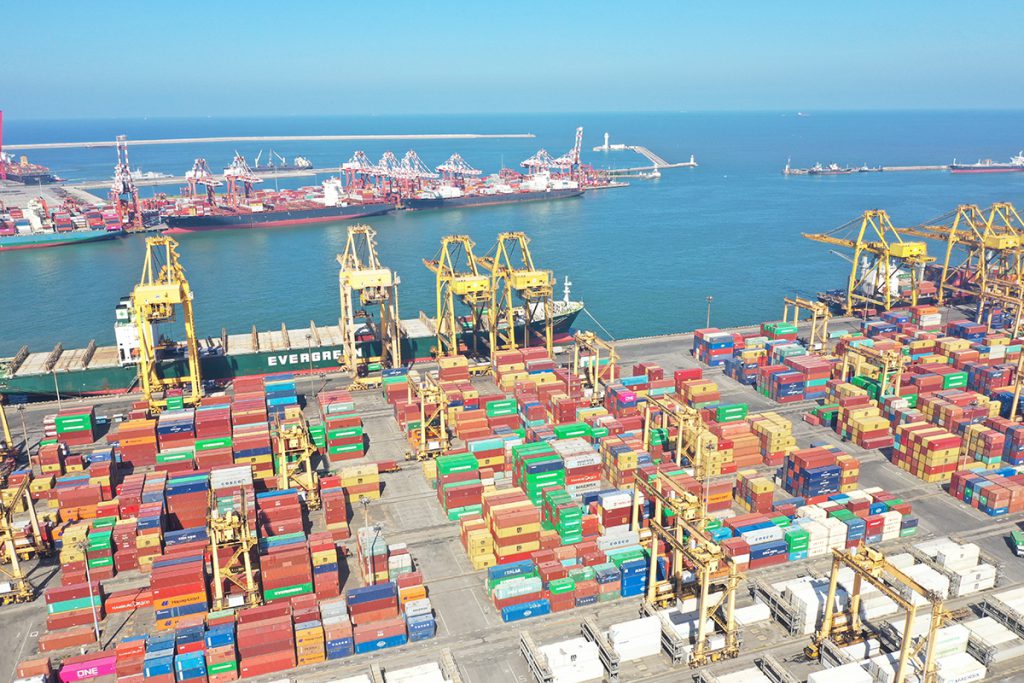
Our propensity for growth is boundless as by 2035 if we could complete north port development and all other projects we are expecting to reach a goal of 35million TEUs and a ranking among the top five ports of the world.
Q: How do you envisage the port of Colombo in 15 years?
A: At present we are ranked as the 22nd port in the world. As per H.E, the President’s vision, within the next few years, by the end of 2024 we will be within the first 15 ports globally. Therefore, we are intentionally and purposefully driving towards the target by creating a major logistics hub, enabling the Port of Colombo to be the preferred destination for transshipment. While we can pin our hopes on being an ideal location geographically, it is imperative that we go beyond this capacity and lay our groundwork from efficiency and professionalism in all areas on par with international standards. We have also seen a YoY growth momentum within the past 1 ½ years, having achieved 7.2million TEUs which needs to be doubled consistently and it is a viable target with the additional developments of Trinco as an industrial port and Galle as a tourist port. However, our propensity for growth is boundless as by 2035 if we could complete north port development and all other projects we are expecting to reach a goal of 35million TEUs and a ranking among the top five ports of the world. With the growth of e-commerce, Asia is set to be the largest consumer of digital consumptions through internet engines, therefore Sri Lanka is an ideal location for storage of goods and dispersion through air, land and water providing a plethora of opportunities and multi-dimensional growth spurts to be a developed nation. Thus the Port sector is seen as a catalyst, taking Sri Lanka towards this goal if we continue this momentum we have started as of now.





